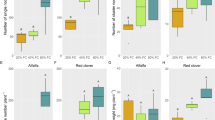Summary
Hyparrhenia filipendula stapf., a tall (1–1.5 m) perennial grass common in dry-subhumid African savannas, was collected from Serengeti National Park in Tanzania, propagated vegetatively, and grown in controlled environments simulating conditions in nature. Plants were subjected to a factorial experiment with combinations of watering frequency, nitrogen supply, clipping height (10 and 15 cm) and clipping frequency (7 and 14 d). Biomass yield and allocation to various tissue types, morphometric traits, and growth processes were measured.
Watering frequency affected leaf elongation rate while nitrogen affected tiller number. Clipped yield was strongly correlated with leaf elongation rate but not tiller number, therefore it was primarily controlled by the activities of intercalary rather than apical meristems. There was a negative exponential relationship between tillering and clipped yield per tiller. Plants that received both high nitrogen and high water closely followed a-3/2 power law in this tradeoff. The fraction of total net photosynthate allocated to roots was not significantly related to any environmental treatment. Root and crown growths were not affected by defoliation treatment; leaf blade and stem growths were inhibited; and sheaths were inhibited only under low water.
Despite a tall stature, H. filipendula tolerated herbivory by increased photosynthetic rate (Wallace et al. 1984), through continued production of young tissues by intercalary meristems balanced against tiller number, and by a statistically constant proportional allocation to roots. Clipped yield increased only when both nitrogen and water were abundant, and then, proportional clipped yield did not surpass an upper asymptotic limit.
Similar content being viewed by others
References
Caldwell MM, Richards JH, Johnson DA, Nowak RS, Dzurec RS (1981) Coping with herbivory: Photosynthetic capacity and resource allocation in two semiarid Agropyron bunchgrasses. Oecologia (Berlin) 50:14–24
Coughenour MB (1984) A mechanistic simulation analysis of water use, leaf angles, and grazing in East-African graminoids. Ecological Modeling 26:203–220
Coughenour MB, McNaughton SJ, Wallace LL (1984a) A mechanistic simulation model of perennial graminoid growth uniting physiological processes and morphometric traits. Ecological Modeling 23:107–134
Coughenour MB, McNaughton SJ, Wallace LL (1984b) Simulation study of East-African perennial graminoid responses to defoliation. Ecological Modeling 26:177–201
Coughenour MB, McNaughton SJ, Wallace LL (1985) Responses of an African graminoid (Themeda triandra Forsk.) to frequent defoliation, nitrogen, and water — A limit of adaptation to herbivory. Oecologia (Berlin) (in press)
Detling JK, Dyer MI, Winn DT (1979) Net photosynthesis, root respiration, and regrowth of Bouteloua gracilis following simulated grazing. Oecologia (Berlin) 41:127–134
Gorham E (1979) Shoot height, weight, and standing crop in relation to density of monospecific stands. Nature 279:148–150
Harper JL (1981) The concept of population in modular organisms. Pages 53–77 in R.M. May, editor, Theoretical Ecology, Second Edition. W.B. Saunders Company, Philadelphia
Helwig JG, Council KA, editors (1979) SAS User's guide. SAS Institute Inc., Raleigh, N.C.
Jager TJ (1982) Soils of the Serengeti Woodlands. Ph.D. Dissertation, Agricultural University, Wageningen, The Netherlands
Ludlow MM, Wilson GL (1971) Photosynthesis of tropical pasture plants III. Leaf age. Australian Journal of Biological Science 24:1077–1087
McNaughton SJ (1979) Grazing as an optimization process: Grassungulate relationships in the Serengeti. American Naturalist 113:691–703
McNaughton SJ (1983) Serengeti grassland ecology: the role of composite environmental factors and contingency in community organization. Ecological Monographs 53:291–320
McNaughon SJ, Coughenour MB, Wallace LL (1983) Plant adaptation in an ecosystem context: effects of defoliation, nitrogen, and water on growth of an African C4 sedge. Ecology 64:307–318
Mufandaedza JT (1976a) Effects of frequency and height of cutting on the yield, composition, and quality of grass only and grasslegume mixtures. Pages 180–183 in: Rhodesia Division of Livestock and Pastures Annual Report. Salisbury. (Herbage Abstracts 48 [1978])
Mufandaeza JT (1976b) Effects of frequency and height of cutting on some tropical grasses and legumes. Hypharrenia filipendula and Heteropogon contortus. Rhodesian Journal of Agricultural Research 14:21–38
Norton-Griffiths MD, Herlocker D, Pennycuick L (1975) The patterns of rainfall in the Serengeti ecosystem, Tanzania. East African Wildlife Journal 13:347–374
Noy-Meir I (1975) Stability of grazing systems: an application of predator prey graphs. Journal of Ecology 63:459–481
Pennycuick L (1975) Movements of the migratory wildebeest population in the Serengeti area between 1960 and 1973. East African Wildlife Journal 13:65–87
Quinn JA, Miller RV (1967) A biotic selection study utilizing Muhlenbergia montana. Bulletin of the Torrey Botanical Club 94:423–432
Sinclair ARE (1977) The African Buffalo. University of Chicago Press, Chicago
Strugnell RG, Pigott CD (1978) Biomass, shoot production, and grazing of two grasslands in the Rwenzori National Park, Uganda. J Ecology 66:73–96
Wallace LL, McNaughton SJ, Coughenour MB (1984) Compensatory photosynthetic responses of three African graminoids to different fertilization, watering, and clipping regimes. Botanical Gazette 145:151–156
Whyte RO (1974) Tropical Grazing Lands: Communities and Constituent Species. Dr. W. Junk b.v. Publishers, The Hague
Author information
Authors and Affiliations
Rights and permissions
About this article
Cite this article
Coughenour, M.B., McNaughton, S.J. & Wallace, L.L. Responses of an African tall-grass (Hyparrhenia filipendula stapf.) to defoliation and limitations of water and nitrogen. Oecologia 68, 80–86 (1985). https://doi.org/10.1007/BF00379478
Received:
Issue Date:
DOI: https://doi.org/10.1007/BF00379478




